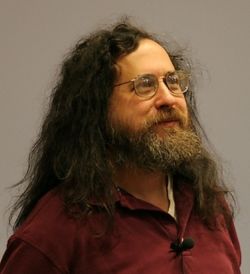The essential freedoms
| Course dashboard for #OCL4Ed | ||
|---|---|---|
| The right license | Video signpost - Frances Ferreira | Introduction | The essential freedoms | Free cultural works | FCW approved licenses | Technology issues | E-Activity - 3rd Learning reflection | |
Contents
Gratis versus libre
In English, the adjective "free" has two meanings: no-cost (gratis) and freedom (libre).The essence of these two meanings underpins the gratis versus libre discussions found in the free software community.[1] This is an important distinction when dealing with differences between information (such as educational content) and property (such as a published book using copyright with all rights reserved).
Richard Stallman, who founded the Free Software Foundation, articulates this difference as follows:
| “ | Free software is a matter of liberty, not price. To understand the concept, you should think of free as in free speech, not as in free beer. [2] | ” |
In the free software community, gratis refers to free beer (as you may be lucky enough to receive at a party) and while you are free to consume the beer, you don't receive any rights of ownership. On the other hand, libre may be likened to freedom of speech, that is liberty meaning free without restrictions. The link between free software and free cultural works is important, because we derive the meaning of free cultural works (free content) from the four essential freedoms defined by the free software movement.
The essential freedoms

- Freedom to use, that is the freedom to run the program, for any purpose (Freedom 0).
- Help yourself which is the freedom to study how the program works, and adapt it to your needs (Freedom 1). Access to the source code is a precondition for this.
- Help your neighbour that is, the freedom to redistribute copies without restriction (Freedom 2).
- Help your community referring to the freedom to improve the program, and release your improvements to the public, so that the whole community benefits (Freedom 3). Access to the source code is a precondition for this.
If any of these freedoms is substantially missing, then it is not free software. For example, so-called freeware, which is copyright software that you can download without cost but without access to the source code, is not free software.
Consider, for example, an OER teaching resource which is stored as a pdf document for download or stored in a closed or proprietary file format.
|
We should recognise that OER is different from free software, however it is useful to think about these essential freedoms when talking about OER, especially when they are stored in digital formats. Revise and remix are considered essential elements of the OER definition. In the activity above, a pdf file which is distributed under an open content license would meet the requirements of Freedom 0 and Freedom 2. However it is more difficult to edit, adapt and modify a pdf file, that is help yourself (Freedom 1) and help your community (Freedom 3), because the pdf is distributed in a "compiled" format and is not directly editable. Similarly, OER which is stored in closed or proprietary file formats are problematic because some educators may not be able to afford the cost of the relevant software licenses or may be required to sacrifice their freedoms regarding preferred software for editing OER. Therefore, we encourage and promote educators to release OER using open and editable file formats.
Copyleft is a copyright hack - a clever solution using copyright law for a purpose the lawmakers did not envisage.
Copyleft turns copyright upside down and uses copyright law to protect and ensure the essential freedoms associated with free software. A software developer, as the legal owner of the code, may choose to release a software program as free software using a Copyleft license. Copyleft is a clever "copyright" requirement that allows anyone to use, modify and adapt the program as long as they release the modifications under the same conditions they received with the original program. In other words, the share-alike provision must be adhered to as part of the copyright of the software. The copyleft provision is said to be viral because it propagates the freedom of the software.
With particular reference to OER, there is an interesting philosophical decision with reference to the copyleft provision:
- Does the creator want to ensure the future freedoms of the teaching materials? In this case the share-alike provision should be used.
- Does the creator want to ensure the future freedoms of users to modify and adapt the resources including the freedom to release derivative works under an all rights reserved copyright? In this case the share-alike provision should not be used and a Creative Commons Attribution (CC BY) license or public domain declaration would meet these objectives. (Note that in the case of a CC BY license, the original materials used for any derivative work would always be legally available for remix because a Creative Commons license is irrevocable.)
Personal reflection on the freedoms educators deem important for learning
|
Both the Creative Commons Attribution (CC BY) and Creative Commons Attribution Share-Alike (CC BY-SA) licenses meet the requirements of the essential freedoms above. In your view, which freedoms are more important for education and learning when choosing between CC BY and CC BY-SA? Post your contribution on WEnotes, twitter or Google+ and include the hash tag "#OCL4Ed" in your post, for example, Use CC BY because ..... #OCL4Ed or Use CC BY-SA because ..... #OCL4Ed. Consider the following questions:
|
Further reading
Notes
- ↑ See Wikipedia article on Gratis versus libre.
- ↑ Free Software Foundation. "The Free Software Definition." Retrieved 5 February 2007.

